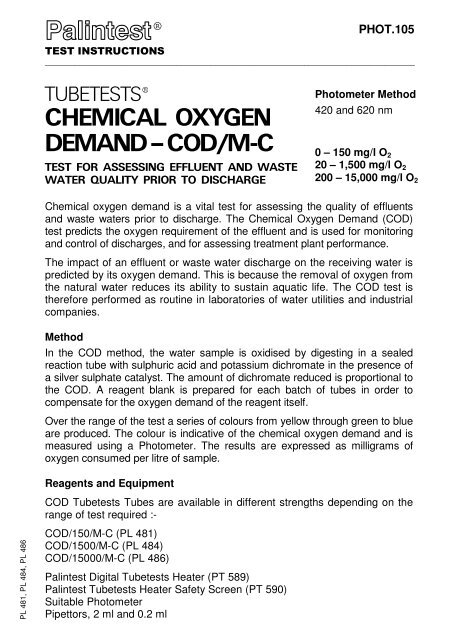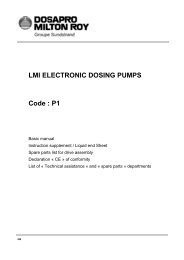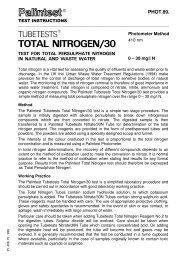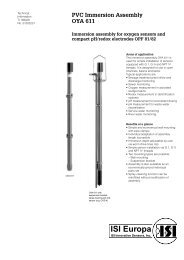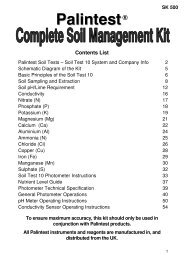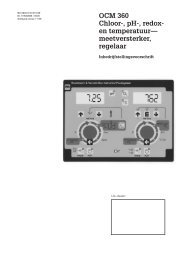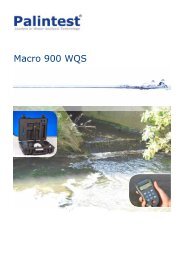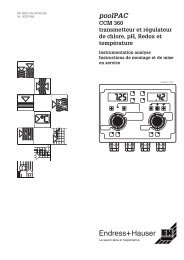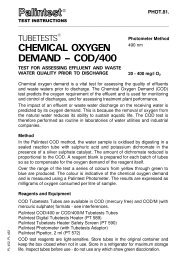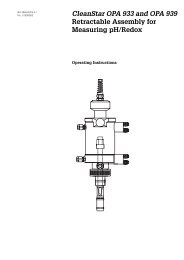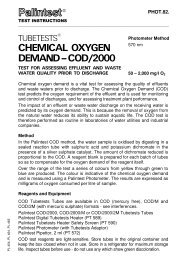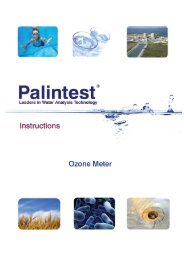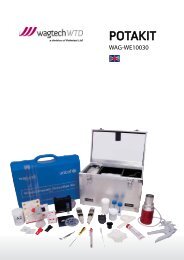Create successful ePaper yourself
Turn your PDF publications into a flip-book with our unique Google optimized e-Paper software.
®PHOT.105TEST INSTRUCTIONS_______________________________________________________________________________________TUBETESTS®CHEMICAL OXYGENDEMAND – <strong>COD</strong>/M-CTEST FOR ASSESSING EFFLUENT AND WASTEWATER QUALITY PRIOR TO DISCHARGEPhotometer Method420 and 620 nm0 – 150 mg/l O 220 – 1,500 mg/l O 2200 – 15,000 mg/l O 2Chemical oxygen demand is a vital test for assessing the quality of effluentsand waste waters prior to discharge. The Chemical Oxygen Demand (<strong>COD</strong>)test predicts the oxygen requirement of the effluent and is used for monitoringand control of discharges, and for assessing treatment plant performance.The impact of an effluent or waste water discharge on the receiving water ispredicted by its oxygen demand. This is because the removal of oxygen fromthe natural water reduces its ability to sustain aquatic life. The <strong>COD</strong> test istherefore performed as routine in laboratories of water utilities and industrialcompanies.MethodIn the <strong>COD</strong> method, the water sample is oxidised by digesting in a sealedreaction tube with sulphuric acid and potassium dichromate in the presence ofa silver sulphate catalyst. The amount of dichromate reduced is proportional tothe <strong>COD</strong>. A reagent blank is prepared for each batch of tubes in order tocompensate for the oxygen demand of the reagent itself.Over the range of the test a series of colours from yellow through green to blueare produced. The colour is indicative of the chemical oxygen demand and ismeasured using a Photometer. The results are expressed as milligrams ofoxygen consumed per litre of sample.PL 481, PL 484, PL 486Reagents and Equipment<strong>COD</strong> <strong>Tubetests</strong> Tubes are available in different strengths depending on therange of test required :-<strong>COD</strong>/150/M-C (PL 481)<strong>COD</strong>/1500/M-C (PL 484)<strong>COD</strong>/15000/M-C (PL 486)<strong>Palintest</strong> Digital <strong>Tubetests</strong> Heater (PT 589)<strong>Palintest</strong> <strong>Tubetests</strong> Heater Safety Screen (PT 590)Suitable PhotometerPipettors, 2 ml and 0.2 ml
<strong>COD</strong> test reagents are light sensitive. Store tubes in the original container and keepthe box closed when not in use. Store in a refrigerator for maximum storage life.Inspect tubes before use - do not use any which show green discoloration.Working PracticeThe <strong>Palintest</strong> <strong>COD</strong> test is a simplified laboratory procedure and should becarried out in accordance with good laboratory working practice. The reagenttubes contain 84% sulphuric acid and must be handled with care. The use ofappropriate protective clothing, gloves and safety spectacles is recommended.In the event of eye contact, rinse with large amounts of water and seekmedical attention immediately. For skin contact, or spillage, wash immediatelywith large quantities of water.Particular care should be taken when opening the reagent tubes to add thewater sample as heat will be produced and gases may be evolved. Samplescontaining cyanide or sulphide will release toxic fumes and for such samplesthe test must always be carried out in a fume cupboard. It is generallyrecommended that the test be conducted in a fume cupboard where available.Reagent tubes should not be opened whilst hot as pressure build-up maycause acid spillage. Do not open tubes after sample digestion.Test CalibrationThese <strong>COD</strong> reagents are designed for use with any compatible photometer.For example, they have been tested and found to be compliant with the directreadingHach DR/<strong>2000</strong> and DR/2500 Odyssey instruments.They are not compatible with <strong>Palintest</strong> direct-reading instruments, for whichdedicated <strong>COD</strong> reagents are available.Reagent BlankIn this test a reagent blank is used instead of the usual water blank referred toin the general photometer operating instructions. The reagent blank isprepared by adding deionised or distilled water to the reagent tube (see TestProcedure, Step 4) and then digesting the tube in the same manner as for thewater sample.It is not necessary to prepare a reagent blank each time the test is carried out.The reagent blank tube may be prepared weekly and used repeatedly with allsamples prepared from the same batch of reagent tubes. The reagent blankshould be stored in the dark, for example in the original packaging between use.Sample PreparationEffluents and waste water samples may contain undissolved or particulatematerial. Such samples may be homogenised in a blender prior to the test inorder to improve accuracy and reproducibility.
Test Procedure1 Turn on <strong>Tubetests</strong> heater, set the control to 150°C and place the safetyshield in position. Allow the heater to heat up to temperature (see<strong>Tubetests</strong> Heater).2 Prepare the SAMPLE TUBE as follows. Shake tube vigorously to suspendall sediment. Remove the cap of the <strong>COD</strong> <strong>Tubetests</strong> tube. Add 2 ml ofsample (150 and 1,500 ranges), or 0.2 ml of sample (15,000 range), usinga <strong>Palintest</strong> pipettor disposable tip dispenser or a standard laboratorypipette.3 Replace the cap tightly and invert tube gently to mix contents. The tubewill become hot on mixing. Ensure all of the precipitate is suspendedbefore proceeding. Label the tube using the labels provided in the reagentpack and place the tube in the <strong>Tubetests</strong> heater. Ensure the safety screenis in position.4 Prepare a REAGENT BLANK by repeating steps 2 and 3 using 2 ml (150 and1,500 ranges), or 0.2 ml (15,000 range) of deionised or distilled water in placeof the sample. This stage may be omitted if a suitable reagent blank tube isalready available (see Reagent Blank).5 Digest the tubes for two hours then turn off the heater unless it is requiredfor further tests.6 Carefully remove each tube, invert gently to mix and then transfer to a testtube rack.7 Allow the tubes to cool to room temperature.8 Select appropriate wavelength on photometer.9 Take the photometer reading (see photometer instructions).InterferencesChloride is the main potential interference in the <strong>COD</strong> test. High chloridelevels may result in an apparent high <strong>COD</strong> result.The method most commonly prescribed in standard analytical methods is theaddition of mercuric sulphate to the reagent system. In the <strong>Palintest</strong> <strong>COD</strong>/M-Ctests, 0.04g of mercuric sulphate is provided in each tube of reagent and willsuppress interference from up to 2,000 mg/l chloride in the sample.DisposalThe used <strong>COD</strong> <strong>Tubetests</strong> tubes contain strong sulphuric acid and otherchemical reagents and care must therefore be exercised in their disposal. Thetube contents should be disposed of in accordance with the laid down disposalprocedures of the laboratory of use. Used tubes must always be treated usinga proper waste disposal system. A <strong>COD</strong> tube disposal service is availablethrough <strong>Palintest</strong> Ltd (UK only). The tubes must not be re-used as they aredesigned for single use only.
<strong>Tubetests</strong> Heaters<strong>Tubetests</strong> heaters are dedicated heaters for use with the <strong>COD</strong> <strong>Tubetests</strong>system. They comprise an electronically controlled dry bath which heatsaluminium test tube blocks and integral safety screen. The heaters aredesigned to provide the correct digesting and refluxing conditions necessaryfor the <strong>COD</strong> test. They provide the correct digestion temperature of 150°C ±3°C in the reagent tubes.To use the digital heater for the <strong>COD</strong> test, set the temperature on the digitaldisplay to 150°C. The operating temperature is shown on the digital display.The display takes into account thermal lag between the block and the heatertubes.On no account must heaters be set at a higher temperature than that specifiedas this may cause a hazard through pressure build-up in the <strong>COD</strong> tubes.___________________________V3-04/08


